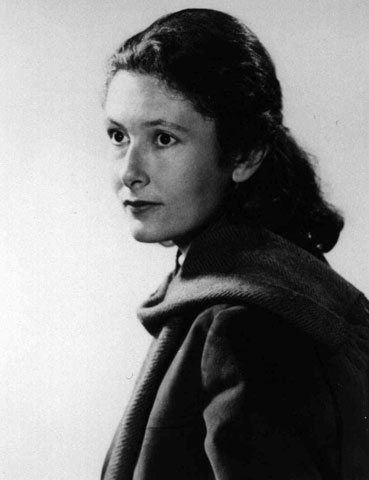
Denise Levertov (AP/New Directions/The Luce Studio)
 DENISE LEVERTOV: A POET’S LIFE
DENISE LEVERTOV: A POET’S LIFE
By Dana Greene
Published by the University of Illinois Press, $35
Dana Greene’s book is filled with 20th-century poets -- and Catholic spiritual leaders who peopled the church before, during and after the Second Vatican Council. This was the church world that poet Denise Levertov, the subject of Greene’s biography, entered. It is a world that will be familiar to many readers, a world remembered with joy.
While this is definitively Levertov’s story, her remarkable life, part of the canon of 20th-century American poets, is also a story of political activism and resistance to the Vietnam War, and of the poets who were participants in those years, and like herself went to jail for their convictions. The activists enriched her life and work.
Levertov was English. She had no formal education, except for a stint in nurses’ training in England. Yet a depth of learning illuminates her writing. She grew up in a home surrounded by books and music, an appreciation of art, a talented older sister -- and interesting parents. Her mother’s ethnic background was Welsh, her father a Russian Jew. He converted to Christianity and was ordained in the Anglican church. Her desire to know was nourished in the domestic space created by her parents, although they were unable to inculcate a sense of religious piety in either of their daughters. Levertov was impressed, however, with the beauty of the liturgy and of church architecture, which touched her deeply.
If there is an ideal environment for a poet it probably isn’t a cramped Greenwich Village apartment. Levertov, at her kitchen table, conjured up places of seclusion and delight to write such lines of lyrical truth as:
but the uncommon speech of paradise
tongue in which oracles
speak to beggars and pilgrims
speech akin to light
with which at day’s end and day’s
renewal, mountains
sing to each other across cold villages.
One can more easily imagine its composition in a calm, quiet pastoral setting. Levertov, of necessity, tended her craft -- more properly her vocation -- during the early years of marriage and motherhood in a small, crowded Greenwich Village apartment where her husband, Mitch Goodman, was often depressed and her small son was given to tantrums. Earlier, Levertov had romanticized a life in New York City, but found the city filled with “materialistic hordes of people.”
Biographer Greene (disclosure: we are friends) uses the lens of place to gain some understanding of Levertov’s development as both a person and a poet. Everything Levertov accomplished -- and it was considerable -- happened in the mesh of domesticity. A Maine farmhouse where the family spent summers and some holidays offered an alternative to the high energy life of the “city that never sleeps.” They built a writing studio on the property -- but Levertov’s husband occupied it. She, on the other hand, continued to use the kitchen table as her writing space.
Through the years of her marriage to Goodman, Levertov found ways to support the family: poetry readings, teaching, and prizes that brought with them monetary rewards. After their divorce (a painful decision) she continued to provide him with financial help, even after he remarried. Levertov’s generosity -- to family, friends, other poets -- is a major theme of the biography.
Mentors were always part of Levertov’s life -- her parents and her older sister, but poets and writers who mentored her either directly or from afar. Rainer Maria Rilke is always in the background of her life, a subtle influence. After her arrival in New York the poet William Carlos Williams became a major influence.
Greene believes that “if Williams changed her poetry, he also changed her life. It was he who showed her how one could be a poet while leading an ordinary life.” Levertov described his influence this way: “He helped me deal with being a grown woman, with a husband and baby, and very little money, in a strange country, a strange city and a language while ostensibly the same in which I had grown up … was different in pace, rhythm and nuance.”
The shift in her poetry, becoming more explicitly religious, happened in large part because of new circles of friends from the Catholic Worker and other milieus who were themselves religious and who helped her explore her emerging interior life. They taught her indirectly about the power of forgiveness and reconciliation as she tried to express the difference between believing in God and loving God. She discovered spiritual direction and liturgy (again) and how the paths of art and faith intersect. She wrote a set of poems inspired by Julian of Norwich. Poetry is work that “enfaiths,” she wrote. She speculated that writing poetry might be her own way of praying. Greene enters into Levertov’s life using the skills and expertise of a historian. She has produced a work akin to her lives of other women whose spiritual depths have the power to inspire: Evelyn Underhill, the Anglo-Catholic spiritual and religious writer and pacifist, and the more famed Catholic writer Maisie Ward, who was also half of the publishing duo Sheed & Ward.
The Levertov biography sits neatly between the two, all three to be read and savored.
[Working on three planned books, on Alzheimer’s, on solitude in the 21st century, and on the vibrant life of cities, Dolores Leckey is a senior fellow, emerita, of Woodstock Theological Center.]


